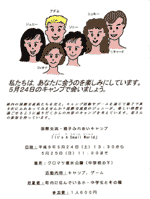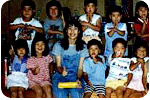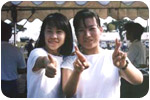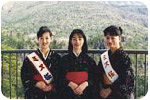Jenny Huang
2016/6/20
CIR 1996-97; Kagoshima-ken, Sakurajima-cho
 One of the comments I often hear from others who have also lived in Japan is how difficult it is to get past the walls of the uchi-soto structure. No matter how long they have been in a community, they are still treated as "visitors" or "guests." My experience working in Sakurajima, Japan as a small town Coordinator for International Relations gave me an opportunity to venture beyond this barrier.
One of the comments I often hear from others who have also lived in Japan is how difficult it is to get past the walls of the uchi-soto structure. No matter how long they have been in a community, they are still treated as "visitors" or "guests." My experience working in Sakurajima, Japan as a small town Coordinator for International Relations gave me an opportunity to venture beyond this barrier. Having studied and lived in Fukuoka City before, I thought that I knew what my JET experience would be like. However, when I arrived at the airport in Kagoshima, there was an unexpected feeling of unfamiliarity at the bottom of my stomach. The year that followed proved just how different this JET year would be from my student days in Fukuoka.
Having studied and lived in Fukuoka City before, I thought that I knew what my JET experience would be like. However, when I arrived at the airport in Kagoshima, there was an unexpected feeling of unfamiliarity at the bottom of my stomach. The year that followed proved just how different this JET year would be from my student days in Fukuoka. Being Asian, I was used to going unnoticed wherever I went in Japan, but that changed after my picture was published in the town newsletter. Apparently, I had one of those "familiar" faces because people constantly told me that I reminded them of someone. Remembering what had been said about how difficult it is to fit in as a foreign-looking foreigner, I seized the opportunity to appeal to the townspeople as the "girl next door." Eager to engage people in discussions on kokusai koryu (internationalization), I patiently sat through numerous lunches and "after-five" hangouts with my coworkers. However, after several months,
Being Asian, I was used to going unnoticed wherever I went in Japan, but that changed after my picture was published in the town newsletter. Apparently, I had one of those "familiar" faces because people constantly told me that I reminded them of someone. Remembering what had been said about how difficult it is to fit in as a foreign-looking foreigner, I seized the opportunity to appeal to the townspeople as the "girl next door." Eager to engage people in discussions on kokusai koryu (internationalization), I patiently sat through numerous lunches and "after-five" hangouts with my coworkers. However, after several months,  our conversations still didn't get past general greetings and subjects such as, "What did you do last weekend?" When I tried to solicit help for my project (an international exchange camp for families and Japanese speaking CIRs), people seemed uninterested in either helping or participating. Even though I made efforts to eat, play, and live with people, for some reason, I wasn't able to gain deeper insights into their interests or carry on the kind of cultural exchange that would meet their needs.
our conversations still didn't get past general greetings and subjects such as, "What did you do last weekend?" When I tried to solicit help for my project (an international exchange camp for families and Japanese speaking CIRs), people seemed uninterested in either helping or participating. Even though I made efforts to eat, play, and live with people, for some reason, I wasn't able to gain deeper insights into their interests or carry on the kind of cultural exchange that would meet their needs. Then one night, a three-hour conversation with a coworker changed my perspective. While standing in the parking lot, we discussed his concerns about the fate of the town in 10 years, after most of the young people left the town to work in large cities. We talked about whether certain town policies that had been drafted would help keep the community together. That was when I realized that I had been so preoccupied with my own goals that I had lost sight of some of the bigger challenges the town was facing. After that conversation, I had other opportunities to talk to people about similar issues. Although the topic of "internationalization" never came up, in my heart, I knew that cross-cultural exchange really was taking place. These conversations helped me see that internationalization wasn't one particular program to be prioritized above others, but was simply an entry way through which we could step into Japanese communities and experience their culture and lifestyles on deeper levels.
Then one night, a three-hour conversation with a coworker changed my perspective. While standing in the parking lot, we discussed his concerns about the fate of the town in 10 years, after most of the young people left the town to work in large cities. We talked about whether certain town policies that had been drafted would help keep the community together. That was when I realized that I had been so preoccupied with my own goals that I had lost sight of some of the bigger challenges the town was facing. After that conversation, I had other opportunities to talk to people about similar issues. Although the topic of "internationalization" never came up, in my heart, I knew that cross-cultural exchange really was taking place. These conversations helped me see that internationalization wasn't one particular program to be prioritized above others, but was simply an entry way through which we could step into Japanese communities and experience their culture and lifestyles on deeper levels.After removing the uchi-soto barrier within myself, I was able to experience Japan in a new and dynamic way. In the end, not only had I become Sakurajima-cho's neighbor, but I had also become a daughter, a sister, and a friend. I am grateful to the JET Program for the transformational experience.
